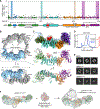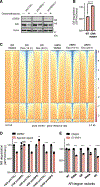UBR5 forms ligand-dependent complexes on chromatin to regulate nuclear hormone receptor stability
- PMID: 37478846
- PMCID: PMC11134608
- DOI: 10.1016/j.molcel.2023.06.028
UBR5 forms ligand-dependent complexes on chromatin to regulate nuclear hormone receptor stability
Abstract
Nuclear hormone receptors (NRs) are ligand-binding transcription factors that are widely targeted therapeutically. Agonist binding triggers NR activation and subsequent degradation by unknown ligand-dependent ubiquitin ligase machinery. NR degradation is critical for therapeutic efficacy in malignancies that are driven by retinoic acid and estrogen receptors. Here, we demonstrate the ubiquitin ligase UBR5 drives degradation of multiple agonist-bound NRs, including the retinoic acid receptor alpha (RARA), retinoid x receptor alpha (RXRA), glucocorticoid, estrogen, liver-X, progesterone, and vitamin D receptors. We present the high-resolution cryo-EMstructure of full-length human UBR5 and a negative stain model representing its interaction with RARA/RXRA. Agonist ligands induce sequential, mutually exclusive recruitment of nuclear coactivators (NCOAs) and UBR5 to chromatin to regulate transcriptional networks. Other pharmacological ligands such as selective estrogen receptor degraders (SERDs) degrade their receptors through differential recruitment of UBR5 or RNF111. We establish the UBR5 transcriptional regulatory hub as a common mediator and regulator of NR-induced transcription.
Keywords: HECT-E3 ligases; nuclear receptors; protein degradation; structural biology; ubiquitin ligases.
Copyright © 2023 The Authors. Published by Elsevier Inc. All rights reserved.
Conflict of interest statement
Declaration of interests B.L.E. has received research funding from Celgene, Deerfield, Novartis, and Calico and consulting fees from GRAIL. He is a member of the Scientific Advisory Board and shareholder for Neomorph Inc., TenSixteen Bio, Skyhawk Therapeutics, and Exo Therapeutics. A.S.S. received consulting fees from Adaptive Technologies. N.H.T. receives funding from the Novartis Research Foundation and is a member of the Scientific Advisory Board of Monte Rosa Therapeutics. K.A.D. is a consultant to Kronos Bio and Neomorph Inc. E.S.F. is a founder, Scientific Advisory Board (SAB) member, and equity holder of Civetta Therapeutics, Lighthorse Therapeutics, Proximity Therapeutics, and Neomorph, Inc. (also board of directors). B.L.E. and M.S. have received research funding from Calico Life Sciences LLC. E.S.F. is an equity holder and SAB member for Avilar Therapeutics and Photys Therapeutics and a consultant to Odyssey, Novartis, Sanofi, EcoR1 Capital, Ajax Therapeutics, and Deerfield. The Fischer lab receives or has received research funding from Deerfield, Novartis, Ajax, Interline, and Astellas.
Figures






Comment in
-
To be (in a transcriptional complex) or not to be (promoting UBR5 ubiquitylation): That is an answer to how degradation controls gene expression.Mol Cell. 2023 Aug 3;83(15):2616-2618. doi: 10.1016/j.molcel.2023.07.010. Mol Cell. 2023. PMID: 37541216
References
-
- Wang L, Oh TG, Magida J, Estepa G, Obayomi SMB, Chong LW, Gatchalian J, Yu RT, Atkins AR, Hargreaves D, et al. (2021). Bromodomain containing 9 (BRD9) regulates macrophage inflammatory responses by potentiating glucocorticoid receptor activity. Proc. Natl. Acad. Sci. USA 118, e2109517118. 10.1073/pnas.2109517118. - DOI - PMC - PubMed
Publication types
MeSH terms
Substances
Grants and funding
LinkOut - more resources
Full Text Sources
Molecular Biology Databases
Research Materials

